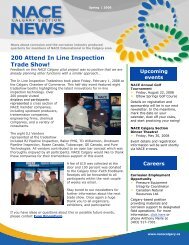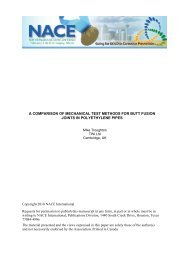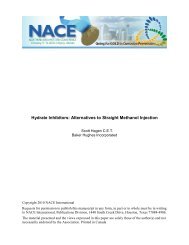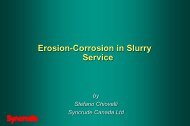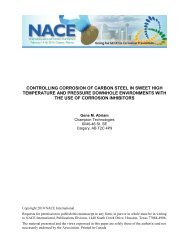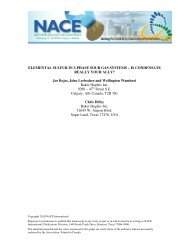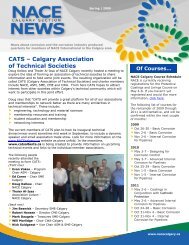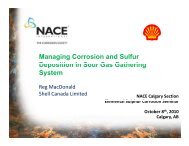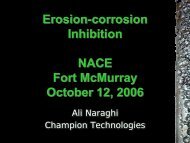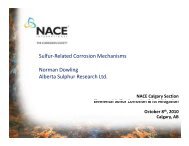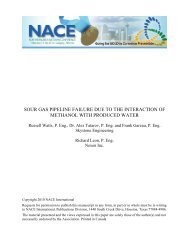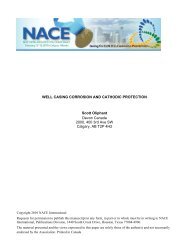Summer, 2010 - NACE Calgary
Summer, 2010 - NACE Calgary
Summer, 2010 - NACE Calgary
You also want an ePaper? Increase the reach of your titles
YUMPU automatically turns print PDFs into web optimized ePapers that Google loves.
SUMMER | <strong>2010</strong><br />
Winter <strong>2010</strong> page 1<br />
Spring | 2007<br />
News about corrosion and the corrosion industry produced<br />
quarterly for members of <strong>NACE</strong> International in the <strong>Calgary</strong> area<br />
News about corrosion and the corrosion industry produced<br />
quarterly for members of <strong>NACE</strong> International in the <strong>Calgary</strong> area<br />
<strong>NACE</strong> Annual Dinner a great success!<br />
More than 130 people participated in this year’s annual dinner.<br />
They enjoyed a renowned entertainer, a luscious meal, and a<br />
fun opportunity to mix and mingle with colleagues and friends.<br />
The dinner took place on June 4 at the <strong>Calgary</strong> Chamber of<br />
Commerce. It is becoming so popular that <strong>NACE</strong> <strong>Calgary</strong> may<br />
have to move to a larger venue next year to accommodate the<br />
growing interest in this fun and entertaining event.<br />
Of Courses…<br />
SAIT Bursary<br />
Recipients…<br />
Designing for<br />
Corrosion Control -<br />
August 9-13 –<br />
Click here for more<br />
information and to<br />
register<br />
Basic Corrosion –<br />
October 25-29 –<br />
Click here for more<br />
information and to<br />
register.<br />
Basic Corrosion –<br />
November 1-5 –<br />
Click here for more<br />
information and to<br />
register.<br />
Internal Corrosion<br />
for Pipelines – Basic<br />
November 1-5 –<br />
Click here to register<br />
with <strong>NACE</strong><br />
International.<br />
Award winning entertainer Wayne Lee provided a highly<br />
interactive hypnosis show throughout the evening that was as<br />
unique as it was hilarious. One participant said of the entire<br />
dinner experience that “This was one of the funnest events I<br />
have ever attended!”<br />
CP4 – Cathodic<br />
Protection Specialist –<br />
late fall, <strong>2010</strong> - Watch<br />
for details.<br />
www.nacecalgary.ca
Winter <strong>2010</strong> page 2<br />
Chair’s Column<br />
In my last address to our membership, I would<br />
like to express my deepest appreciation and<br />
respect for those members who have actively<br />
participated with me on the <strong>Calgary</strong> <strong>NACE</strong><br />
Executive Committee, as well as on the <strong>2010</strong><br />
Western Conference Organizing Committee.<br />
What an impressive accumulation of<br />
talent and enthusiasm we have to draw from,<br />
which is the direct reason why <strong>Calgary</strong> holds the distinction of being<br />
one of the most successful <strong>NACE</strong> Sections in North America. I am also<br />
honored to recognize some additional members for their individual<br />
accomplishments and commitment to the <strong>Calgary</strong> <strong>NACE</strong> Section…<br />
25 & 35 year service award recipients:<br />
• Ron Hazelwood – 25 Years<br />
• Dale Grey – 25 Years<br />
• Graham Trone – 35 Years<br />
SAIT Bursary<br />
Recipients…<br />
Eric Smith<br />
For their special dedication to education as <strong>NACE</strong> Instructors:<br />
• Jerry Bauman<br />
• Pat Teevens<br />
For his strong commitment to “corrosion education”,<br />
representing <strong>NACE</strong> <strong>Calgary</strong> Section at the Annual Youth Science<br />
Fair:<br />
• J. H. (Joe) Schulz<br />
Padmini Popuri<br />
SAIT Bursaries<br />
Our association is dedicated to the advancement of education in<br />
corrosion sciences, and it is with great pride that I recognize our five<br />
SAIT Student recipients of the $1000 <strong>NACE</strong> Bursaries in <strong>2010</strong>:<br />
• Miles Nicholson – Power Engineering Technology<br />
• Murray Hollman – Welding Engineering Technology<br />
• Eric Smith – Chemical Engineering Technology<br />
• Travis Hamilton – Petroleum Engineering Technology<br />
• Padmini Popuri – Chemical Laboratory Technology<br />
Miles Nicholson<br />
Finally, as my last official act, I would like to sincerely thank all <strong>NACE</strong><br />
<strong>Calgary</strong> members for your ongoing support, with a special thanks to all<br />
of our industry employers and corporate sponsors who share in our<br />
success as individual professionals and as a professional association.<br />
Sincerely,<br />
Douglas Kellow<br />
Chairman, <strong>Calgary</strong> <strong>NACE</strong> Section<br />
Travis Hamilton<br />
www.nacecalgary.ca
Winter <strong>2010</strong> page 3<br />
Estevan Integrity Management Seminar<br />
This seminar held in Estevan, Saskatchewan on April 22, was<br />
highly successful and helped to raise the profile of <strong>NACE</strong> in<br />
Saskatchewan. Click here to view conference papers.<br />
Upcoming<br />
Conferences…<br />
Northern Area<br />
Eastern Conference<br />
<strong>2010</strong>,Montreal, QC,<br />
Canada, October 17-<br />
19, <strong>2010</strong>. Click here<br />
for information.<br />
Northern Area<br />
Western Conference<br />
2011, Regina,<br />
Saskatchewan,<br />
February 6-8, <strong>2010</strong><br />
Click here for<br />
information about the<br />
Call for Papers.<br />
<strong>NACE</strong> <strong>Calgary</strong><br />
Member Survey<br />
<strong>NACE</strong> <strong>Calgary</strong> Golf Tournament<br />
The annual <strong>NACE</strong> <strong>Calgary</strong> golf tournament has provided <strong>NACE</strong><br />
<strong>Calgary</strong> members and colleagues with an opportunity to network<br />
in an enjoyable environment for more than 20 years.<br />
The tournament will once again take place this year on Friday,<br />
August 20 at Elbow Springs Golf and Country Club in<br />
<strong>Calgary</strong>.<br />
Extensive sponsorships make this event affordable for all and<br />
enable everyone to receive a prize of some kind.<br />
The Registration site will be available soon. Watch for an enews<br />
with the registration link. In the meantime, contact<br />
arrangements1@nacecalgary.ca for more information.<br />
Every two years the <strong>NACE</strong><br />
<strong>Calgary</strong> Executive<br />
Committee conducts an<br />
online survey in order to<br />
gather the views and ideas<br />
of members to assist in<br />
planning for events, courses<br />
and communications to<br />
members.<br />
The Executive created a<br />
benchmark survey four<br />
years ago and this will be<br />
the third time they have<br />
reached out to members to<br />
tap their expertise.<br />
The survey will soon be<br />
available online. Members<br />
will receive the link via<br />
email.<br />
www.nacecalgary.ca
Winter <strong>2010</strong> page 4<br />
Several <strong>NACE</strong> <strong>Calgary</strong> members were honored at the annual dinner. Left to right: Patrick<br />
Teevens, <strong>NACE</strong> instructor; Graham Trone, 35 year <strong>NACE</strong> member; Dale Grey, 25 year <strong>NACE</strong><br />
member; J. H. (Joe) Schulz, corrosion education through <strong>Calgary</strong> Science Fair.<br />
Incoming Chair’s Comments<br />
This coming<br />
September, I will<br />
be inheriting a<br />
very sound ship,<br />
both from an<br />
organizational<br />
and financial<br />
standpoint.<br />
A large part of the recent success of the<br />
<strong>Calgary</strong> section has to be attributed to our<br />
current leader, Doug Kellow. Doug has<br />
dedicated many hours of his personal and<br />
professional life to making our group a strong<br />
one, ensuring the right people were in the<br />
proper positions, making the best decisions.<br />
I am pleased to say that Doug will be<br />
continuing on at the Northern Area Regional<br />
level as the <strong>Calgary</strong> Section Trustee, where I<br />
am sure he will make a great impact on the<br />
organization.<br />
The list of great things Doug has done for our<br />
group is too long to mention in detail, but one<br />
in particular that I think he is proud of is<br />
building a process to properly recognize<br />
individuals and companies who support <strong>NACE</strong>.<br />
That occasional pat on the back and<br />
recognition that efforts have not gone unnoticed<br />
is a powerful tool when it comes to<br />
companies and individuals within <strong>NACE</strong><br />
<strong>Calgary</strong>.<br />
I’m quite excited about the group Doug has<br />
built and I look forward to continuing to<br />
address our Section’s goal of protecting<br />
people, assets and the environment from the<br />
ongoing effects of corrosion.<br />
Evan Bloomfield<br />
Incoming Chair<br />
<strong>NACE</strong> <strong>Calgary</strong> Section<br />
DOUG KELLOW<br />
<strong>NACE</strong> CALGARY EXECUTIVE CHAIR<br />
2008-<strong>2010</strong><br />
In Appreciation of Outstanding Service and<br />
Education<br />
From the <strong>NACE</strong> <strong>Calgary</strong> Section<br />
www.nacecalgary.ca
Winter <strong>2010</strong> page 5<br />
Trophy winner shows great promise<br />
By J.H. (Joe) Schulz, Bio-Chem Consulting Services (1980) Ltd<br />
It gives me great pleasure to announce that the<br />
winner of the <strong>NACE</strong> <strong>Calgary</strong> Section Trophy at the<br />
<strong>2010</strong> <strong>Calgary</strong> Youth Science Fair is Evan Lambie.<br />
Evan just completed Grade 6 at Rundle College<br />
Elementary. His project was “Just Sit Back, Relax<br />
and Rust”. His objective was to illustrate which of<br />
the metals he selected for his study would be most<br />
resistant to corrosion when exposing the specimen<br />
to different liquids.<br />
Evan describes his project as follows:<br />
My metals were copper, aluminum, black iron and<br />
galvanized steel and the liquids I used were fresh,<br />
salt, basic and acidic water. I did this experiment<br />
by taking metals, which I had four of each, and<br />
dipping one of each metal in a specific liquid. I<br />
dipped the metals every morning before I went to<br />
school and every night. I recorded my observations<br />
every night before I dipped the metals. My<br />
observations estimated what percent of the metal<br />
surface area I thought was covered in corrosion. I<br />
repeated this for 13 days and I took pictures every<br />
few days to keep a record of what the metals<br />
looked like throughout the 13 days. I dipped the<br />
metals during my experiment because metal needs<br />
air to corrode and a liquid to speed up the process.<br />
At the end of my experiment I graphed the percent<br />
corrosion against the number of days to determine<br />
which metal corroded the least. Aluminum ended<br />
up as the least corroded metal confirming that my<br />
hypothesis was correct. My experiment can help<br />
people by showing which metal should be used in<br />
certain environments.<br />
As is standard procedure at the <strong>Calgary</strong> Youth<br />
Science Fair, all submitted projects are vetted in<br />
the morning and than the top projects are<br />
recommended for afternoon judging, with a view to<br />
identifying all projects that are worthy of various<br />
scholarships, bursaries and trophies.<br />
Evan’s project met all criteria very easily. His<br />
subject knowledge, combined with his genuine<br />
enthusiasm, made it very easy for the judging<br />
committee to recommend him for our <strong>NACE</strong><br />
<strong>Calgary</strong> <strong>2010</strong> award.<br />
As the team leader of the panel of Science Fair<br />
judges designated to select major award recipients<br />
in the area of Physical Sciences, I would also like<br />
to congratulate Evan on his intuitive presentation<br />
style and his deep understanding of the material<br />
he presented.<br />
A great opportunity for mentorship!<br />
The Science Fair, largely organized by the <strong>Calgary</strong><br />
public school boards, primarily encourages Grade 5<br />
& 6 students to participate, while some students in<br />
Grades 7 to 12 – usually very gifted – also<br />
participate, because they enjoy showcasing their<br />
projects and their often vast science knowledge.<br />
Many of these young scientists become leaders in<br />
their chosen profession.<br />
Each year, the top 10 projects from each of the<br />
regional science fairs are invited to participate in<br />
the National Science Fair, held on a rotating basis<br />
in all parts of our nation on an annual basis.<br />
Mentorship of young people is such a critical<br />
component of their schooling process and I<br />
encourage all our <strong>NACE</strong> <strong>Calgary</strong> members to<br />
participate in the process of working with our<br />
young people, either at home with their own<br />
children, at the school level or perhaps even at the<br />
science fairs as judges.<br />
On an entirely personal note…<br />
I would like to thank my peers at <strong>NACE</strong> <strong>Calgary</strong> for<br />
recently honoring me at the Annual Dinner for my<br />
“commitment to education in corrosion sciences”. I<br />
was honored to be recognized and thank everyone<br />
for the thoughtfulness extended to me.<br />
Are you interested in being a Science Fair judge<br />
Click here for more information.<br />
www.nacecalgary.ca
Winter <strong>2010</strong> page 6<br />
For Your Information…<br />
Featuring some of the worst corrosion related failures recorded around the world, along with<br />
historical references and lessons learned.<br />
Assembled by Thaier Al-Issa, SulfaTreat Canada<br />
Rupture and fire on two natural gas pipelines at Station 30<br />
on TransCanada Pipelines property near Rapid City, Manitoba 29 July 1995<br />
“At 05:42 EST, on 29 July 1995, an initial rupture and a fire occurred on the TransCanada PipeLines Limited<br />
(TCPL) 1,067-mm (42-inch) natural gas pipeline at Kilometre Post Main Line Valve 30-4 + 0.220 km near<br />
Rapid City, Manitoba. At 06:34 EST, a second rupture and a fire occurred on the 914-mm (36-inch) natural<br />
gas pipeline at Kilometre Post Main Line Valve 30-3 + 0.245 km, adjacent to the first rupture, at the same<br />
location. The 1,219-mm (48-inch) natural gas pipeline at Kilometre Post Main Line Valve 30-5 + 0.347 km,<br />
passing under the location of the first and second pipeline ruptures, was exposed to the fire but did not<br />
rupture.” (www.tsb.gc.ca/eng/rapports-reports/pipeline/1995/p95h0036/p95h0036.asp)<br />
TCPL Compressor Station 30 (TransCanada, 2005) Ruptured Lines 100-3 and 100-4<br />
Incident failure investigation and results:<br />
• Line 100 – 4 rupture was caused by a fracture located at the toe of a longitudinal seam (DSAW -<br />
Double submerged arc welding) as a result of external Stress Corrosion Cracking. (Metal loss of<br />
81% of WT) in a transition piece of pipe. The fracture had initiated from a pre-existing defect.<br />
• Line 100 – 3 rupture was caused by heat overload as a result of failure of Line 100 – 4 due to an<br />
inadequate horizontal spacing between lines.<br />
• Programming errors in the SCADA system resulted in failure of ESD systems<br />
• Inadequate process and procedures to address areas susceptible to SCC.” (Team -1 presentation –<br />
ENME 619.55 IMP, U of <strong>Calgary</strong>, winter 2008)<br />
www.nacecalgary.ca
Winter <strong>2010</strong> page 7<br />
Root Cause – Fish Bone Analysis<br />
Analisys of the Manitoba Pipeline Rupture Vs ASME B31.8s - 2004 Pipeline Integrity Management Program Requirements<br />
Denotes Key Area of Investigation<br />
1. Performance Plan 2. Communication Plan 3. Management of Change Plan<br />
Process or activity Measure<br />
Operational Measures<br />
Direct Integrity Measure<br />
Internal Communication<br />
External Communication<br />
Reason for change<br />
Authority of approval<br />
Analysis of Implications<br />
Documentation<br />
Communication of Change<br />
Time Limitations<br />
Qualification of Staff<br />
Process and documents<br />
identification<br />
Sequence and interaction<br />
Criteria to ensure the operation and<br />
control of documentes is effective<br />
Monitor , measure the processes<br />
Define responsabilities<br />
and authorities<br />
Competence, awareness,<br />
qualification of the personnel<br />
involved in IMP<br />
Threat Assessment<br />
Gathering information<br />
Risk Assessment<br />
Integrity Assessment<br />
Response and Mitigation<br />
SCC FAILURE<br />
INADEQUATE<br />
IM plan<br />
Audits<br />
4. Quality Control Plan<br />
5. Integrity Management Plan<br />
(Team -1 presentation – ENME 619.55 IMP, U of <strong>Calgary</strong>, Winter 2008)<br />
Canadian Regulatory & Industry Response<br />
• Change and acceleration of the scope and depth of the SCC Management Program in Western Canada.<br />
• National Energy Board’s public Inquiry into SCC occurrence on Canadian oil and gas pipeline systems.<br />
The report contains 27 recommendations.<br />
• Revision of the design and redundancy of SCADA systems communication.<br />
• Design ESD systems to automatically isolate the lines in an event of failure.<br />
• Revision of local ESD procedures.<br />
• Revision of standard for Horizontal and Vertical separation of adjacent pipeline” (Team -1 presentation<br />
– ENME 619.55 IMP, U of <strong>Calgary</strong>, winter 2008)<br />
Lessons learned<br />
1. SCC is a serious factor in safe & profitable pipeline systems. SCC became a major component of each<br />
& every preventive maintenance program in the Oil & Gas Industry as well as other industries that<br />
involve material handling & equipment operations.<br />
2. Development of Integrity Management Programs (IMP) as an important tool to identify, plan, monitor<br />
& mitigate risks including SCC in pipeline systems to maintain maximum outcome from these systems<br />
that are carrying valuable commodities.<br />
3. Public awareness is one of the factors in setting higher safety measurements by O&G operators into<br />
their design, construction & operation practices.<br />
4. Development of standards & regulations to control design & construction of O&G facilities are vital to<br />
secure proper, safe & environment friendly operations.<br />
5. Proper training of management and staff responsible for developing and executing the integrity<br />
management program & setting qualifications of consultants and contractors involved with the<br />
integrity management program.<br />
www.nacecalgary.ca
Winter <strong>2010</strong> page 8<br />
6. Development of records of management system allowing timely access, by section, to records<br />
regarding the pipeline system.<br />
7. Pipeline condition monitoring to be a comprehensive, proactive, consistent, process where various<br />
components of the process are reviewed on an ongoing basis and updated as necessary.<br />
8. There should be alternative control system to identify shortcomings in the existing control system and<br />
correct any fault and one system like this is fault-tree analysis which could be applied to an existing<br />
SCADA/ESD system. (Team -1 presentation – ENME 619.55 IMP, U of <strong>Calgary</strong>, winter 2008)<br />
References<br />
• ENME 619.55 IMP, U of <strong>Calgary</strong>, winter 2008, Rapid City, Manitoba Pipeline Rupture, Development<br />
of Pipeline Integrity Management Programs, Team -1 presentation.<br />
• Transportation Safety Board of Canada. (2002). Pipeline Reflexions Magazine. Retrieved January<br />
14, 2009, from http://www.tsb.gc.ca/eng/publications/reflexions/pipeline/2002/numeroissue_3/pipeline-numero-issue-3-sec1.asp<br />
• Transportation Safety Board of Canada. (n.d.). Pipeline Reports – 1995 – P95H0036. Retrieved<br />
January 14, 2009, from http://www.tsb.gc.ca/eng/rapportsreports/pipeline/1995/p95h0036/p95h0036.asp<br />
• National Energy Board. (1996). Report of the inquiry: Stress Corrosion Cracking on Canadian Oil<br />
and Gas Pipelines. <strong>Calgary</strong>, Alberta, Canada: NEB<br />
• The American Society of Mechanical Engineers – ASME. (2004). ASME B31.8s – 2004 Managing<br />
System Integrity of Gas Pipelines. New York, USA.<br />
• National Energy Board of Canada. (n.d.). Guidance notes for the onshore pipeline regulations.<br />
Retrieved January 28, 2009 from http://www.neb-one.gc.ca/clfnsi/rpblctn/ctsndrgltn/rrggnmgpnb/nshrppln/gdncntsfrthnshrpplnrgltn-eng.html#pipeline_integrity<br />
Note: As soon as more information and sufficient analysis is available, we hope to feature in this column the<br />
Deepwater Horizon oil spill in the Gulf of Mexico, considered to be the worst in US history.<br />
<strong>NACE</strong> News is produced four times a year by the<br />
Executive Committee of <strong>NACE</strong> <strong>Calgary</strong> Section, in<br />
December, March, June and September.<br />
To provide feedback or to submit an article or story<br />
idea, email: nacenews@nacecalgary.ca.<br />
www.nacecalgary.ca



